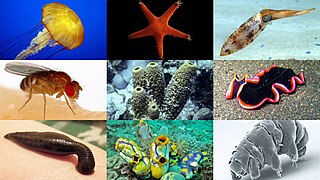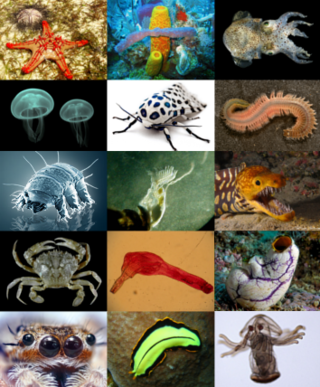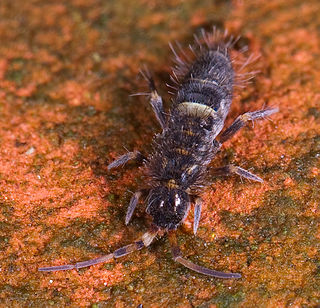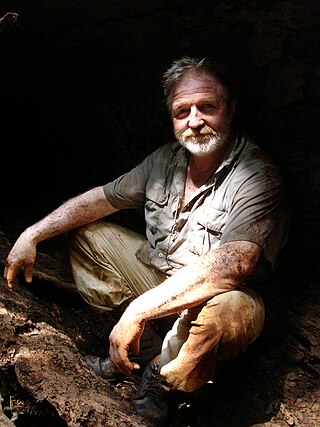Related Research Articles

Invertebrates are a paraphyletic group of animals that neither possess nor develop a vertebral column, derived from the notochord. This is a grouping including all animals apart from the chordate subphylum Vertebrata. Familiar examples of invertebrates include arthropods, mollusks, annelids, echinoderms and cnidarians.

Hemiptera is an order of insects, commonly called true bugs, comprising over 80,000 species within groups such as the cicadas, aphids, planthoppers, leafhoppers, assassin bugs, bed bugs, and shield bugs. They range in size from 1 mm (0.04 in) to around 15 cm (6 in), and share a common arrangement of piercing-sucking mouthparts. The name "true bugs" is often limited to the suborder Heteroptera.

Leafcutter ants, a non-generic name, are any of 47 species of leaf-chewing ants belonging to the two genera Atta and Acromyrmex. These species of tropical, fungus-growing ants are all endemic to South and Central America, Mexico, and parts of the southern United States. Leafcutter ants can carry twenty times their body weight and cut and process fresh vegetation to serve as the nutritional substrate for their fungal cultivates.

Scutigera coleoptrata, also known as the house centipede, is a species of centipede that is typically yellowish-grey and has up to 15 pairs of long legs. Originating in the Mediterranean region, it has spread to other parts of the world, where it can live in human homes. It is an insectivore; it kills and eats other arthropods, such as insects and arachnids.

Scale insects are small insects of the order Hemiptera, suborder Sternorrhyncha. Of dramatically variable appearance and extreme sexual dimorphism, they comprise the infraorder Coccomorpha which is considered a more convenient grouping than the superfamily Coccoidea due to taxonomic uncertainties. Adult females typically have soft bodies and no limbs, and are concealed underneath domed scales, extruding quantities of wax for protection. Some species are hermaphroditic, with a combined ovotestis instead of separate ovaries and testes. Males, in the species where they occur, have legs and sometimes wings, and resemble small flies. Scale insects are herbivores, piercing plant tissues with their mouthparts and remaining in one place, feeding on sap. The excess fluid they imbibe is secreted as honeydew on which sooty mold tends to grow. The insects often have a mutualistic relationship with ants, which feed on the honeydew and protect them from predators. There are about 8,000 described species.

Marine life, sea life, or ocean life is the plants, animals, and other organisms that live in the salt water of seas or oceans, or the brackish water of coastal estuaries. At a fundamental level, marine life affects the nature of the planet. Marine organisms, mostly microorganisms, produce oxygen and sequester carbon. Marine life in part shape and protect shorelines, and some marine organisms even help create new land.
The arthropod leg is a form of jointed appendage of arthropods, usually used for walking. Many of the terms used for arthropod leg segments are of Latin origin, and may be confused with terms for bones: coxa, trochanter, femur, tibia, tarsus, ischium, metatarsus, carpus, dactylus, patella.

The Entognatha are a class of wingless and ametabolous arthropods, which, together with the insects, makes up the subphylum Hexapoda. Their mouthparts are entognathous, meaning that they are retracted within the head, unlike the insects. Entognatha are apterous, meaning that they lack wings. The class contains three orders: Collembola, Diplura and Protura. These three groups were historically united with the now-obsolete order Thysanura to form the class Apterygota, but it has since been recognized that the hexapodous condition of these animals has evolved independently from that of insects, and independently within each order. The orders might not be closely related, and Entognatha is now considered to be a polyphyletic group.

Ambush predators or sit-and-wait predators are carnivorous animals that capture or trap prey via stealth, luring or by strategies utilizing an element of surprise. Unlike pursuit predators, who chase to capture prey using sheer speed or endurance, ambush predators avoid fatigue by staying in concealment, waiting patiently for the prey to get near, before launching a sudden overwhelming attack that quickly incapacitates and captures the prey.

Animals are multicellular, eukaryotic organisms in the biological kingdom Animalia. With few exceptions, animals consume organic material, breathe oxygen, are able to move, can reproduce sexually, and grow from a hollow sphere of cells, the blastula, during embryonic development. As of 2022, 2.16 million living animal species have been described—of which around 1.05 million are insects, over 85,000 are molluscs, and around 65,000 are vertebrates—but it has been estimated there are around 7.77 million animal species in total. Animals range in length from 8.5 micrometres (0.00033 in) to 33.6 metres (110 ft). They have complex interactions with each other and their environments, forming intricate food webs. The scientific study of animals is known as zoology.

A woodlouse is any crustacean belonging to the suborder Oniscidea within the order Isopoda. They get their name from often being found in old wood, and from louse, a parasitic insect, although woodlice are not insects.

Worms are many different distantly related bilateral animals that typically have a long cylindrical tube-like body, no limbs, and no eyes.

Tardigrades, known colloquially as water bears or moss piglets, are a phylum of eight-legged segmented micro-animals. They were first described by the German zoologist Johann August Ephraim Goeze in 1773, who called them Kleiner Wasserbär. In 1777, the Italian biologist Lazzaro Spallanzani named them Tardigrada, which means "slow steppers".

Arthropods are invertebrate animals in the phylum Arthropoda. They possess an exoskeleton with a cuticle made of chitin, often mineralised with calcium carbonate, a segmented body, and paired jointed appendages. In order to keep growing, they must go through stages of moulting, a process by which they shed their exoskeleton to reveal a new one. They are an extremely diverse group, with up to 10 million species.

A wasp is any insect of the narrow-waisted suborder Apocrita of the order Hymenoptera which is neither a bee nor an ant; this excludes the broad-waisted sawflies (Symphyta), which look somewhat like wasps, but are in a separate suborder. The wasps do not constitute a clade, a complete natural group with a single ancestor, as bees and ants are deeply nested within the wasps, having evolved from wasp ancestors. Wasps that are members of the clade Aculeata can sting their prey.

Sexual reproduction is a type of reproduction that involves a complex life cycle in which a gamete with a single set of chromosomes combines with another gamete to produce a zygote that develops into an organism composed of cells with two sets of chromosomes (diploid). This is typical in animals, though the number of chromosome sets and how that number changes in sexual reproduction varies, especially among plants, fungi, and other eukaryotes.

Springtails (Collembola) form the largest of the three lineages of modern hexapods that are no longer considered insects. Although the three orders are sometimes grouped together in a class called Entognatha because they have internal mouthparts, they do not appear to be any more closely related to one another than they are to all insects, which have external mouthparts.

Insects are pancrustacean hexapod invertebrates of the class Insecta. They are the largest group within the arthropod phylum. Insects have a chitinous exoskeleton, a three-part body, three pairs of jointed legs, compound eyes and one pair of antennae. Their blood is not totally contained in vessels; some circulates in an open cavity known as the haemocoel. Insects are the most diverse group of animals; they include more than a million described species and represent more than half of all known living organisms. The total number of extant species is estimated at between six and ten million; potentially over 90% of the animal life forms on Earth are insects. Insects may be found in nearly all environments, although only a small number of species reside in the oceans, which are dominated by another arthropod group, crustaceans, which recent research has indicated insects are nested within.

George C. McGavin is a British entomologist, author, academic, television presenter and explorer.

Human interactions with insects include both a wide variety of uses, whether practical such as for food, textiles, and dyestuffs, or symbolic, as in art, music, and literature, and negative interactions including damage to crops and extensive efforts to control insect pests.
References
- ↑ "Ross Piper". Amazon. Retrieved 9 July 2012.
- 1 2 3 "Biography". Dr. Ross Piper. 19 April 2013. Retrieved 7 March 2017.
- ↑ "Animal Earth: exploring the hidden biodiversity of our planet". news.mongabay.com. 3 December 2013. Retrieved 7 March 2017.
- ↑ University, Bangor. "Ross Piper - Alumnus of the year, 2015 - Bangor University". www.bangor.ac.uk. Retrieved 7 March 2017.
- ↑ Bangor University (22 July 2015), Ross Piper - 2015 Alumnus of the Year , retrieved 7 March 2017
- 1 2 Piper, Ross. "Drugs from bugs: the next blockbuster medicine could be lurking inside an insect". The Conversation. Retrieved 7 March 2017.
- 1 2 Piper, Ross. "Saving bugs in the name of drugs - Geographical" . Retrieved 7 March 2017.
- ↑ Piper, Ross (20 March 2015). Animal Earth: The Amazing Diversity of Living Creatures (1 ed.). London: Thames & Hudson. ISBN 9780500291658.
- ↑ "Wild Burma: Nature's Lost Kingdom - BBC Four". BBC. Retrieved 7 March 2017.
- ↑ zurichminds (1 December 2015), Ross Piper: Forgotten Frontiers (2015 WORLD.MINDS) , retrieved 7 March 2017
- ↑ "Landing page (from ZURICH.minds) – WORLD.MINDS". www.worldminds.com. Retrieved 7 March 2017.
- ↑ "What is EG?". EG Conference. 4 August 2016. Retrieved 7 March 2017.
- ↑ "Ross Piper, Zoologist (EG8)". EG Conference. 22 June 2015. Retrieved 7 March 2017.
- ↑ "Viewpoint: Why Burma's forests must be preserved". BBC News. 28 November 2013. Retrieved 7 March 2017.
- ↑ "Photography". Dr. Ross Piper. 19 April 2013. Retrieved 7 March 2017.
- ↑ Ross Piper (3 March 2011). Pests: A Guide to the World's Most Maligned, Yet Misunderstood Creatures. ABC-CLIO. pp. 283–. ISBN 978-0-313-38426-4 . Retrieved 9 July 2012.